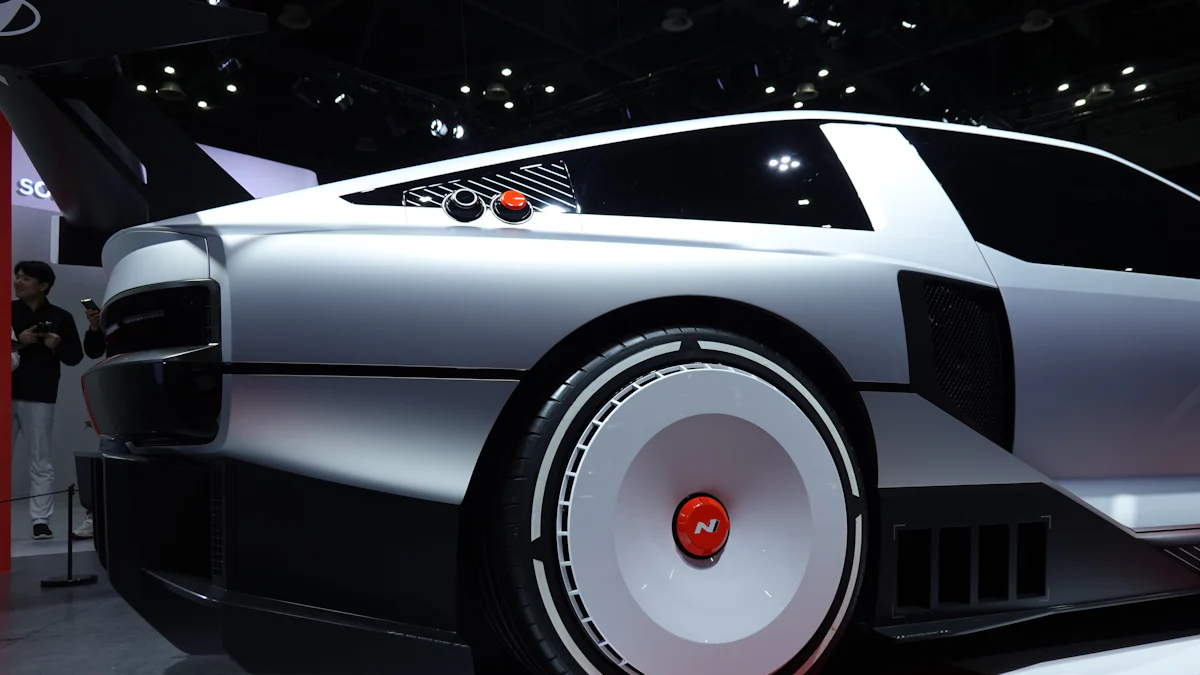Latest Trends in the Global Automotive Market 2024

The global automotive market in 2024 holds significant importance due to its projected growth and technological advancements. Rapid changes and innovations, such as the adoption of electric vehicles and autonomous driving technologies, are reshaping the industry. Staying updated with the latest trends is crucial for industry players to remain competitive and capitalize on emerging opportunities.
Latest Trends in Technological Advancements

Electric Vehicles (EVs)
Growth in EV Sales
The global automotive market has witnessed a significant increase in electric vehicle (EV) sales. Consumers are increasingly opting for EVs due to their environmental benefits and lower operational costs. The market penetration of EVs continues to rise, driven by advancements in battery technology and cost reductions. By 2030, EVs are expected to become more affordable compared to traditional internal combustion engine vehicles.
Advances in Battery Technology
Battery technology has seen remarkable progress, contributing to the growth of the EV market. Innovations in battery chemistry and manufacturing processes have led to higher energy densities and faster charging times. The cost of batteries has also decreased significantly, making EVs more accessible to a broader audience. By the next decade, battery prices are forecasted to decline to $150 to $200 per kilowatt-hour, enhancing the value proposition of EVs.
Government Incentives and Policies
Government incentives and policies play a crucial role in promoting the adoption of EVs. Many countries offer subsidies, tax rebates, and other financial incentives to encourage consumers to purchase EVs. Additionally, governments are investing in the development of charging infrastructure to support the growing number of EVs on the road. These measures aim to reduce greenhouse gas emissions and promote sustainable transportation.
Autonomous Driving
Progress in Self-Driving Technology
Autonomous driving technology has made significant strides in recent years. Advanced driver-assistance systems (ADAS) and artificial intelligence (AI) have enabled vehicles to perceive and interact with their environment more intelligently. Companies like Tesla, Toyota, and BMW are integrating these technologies into their vehicles, paving the way for fully autonomous driving systems. These advancements promise to enhance safety and efficiency in transportation.
Regulatory Challenges
The development and deployment of autonomous driving technology face several regulatory challenges. Governments and regulatory bodies are working to establish safety standards and guidelines for self-driving vehicles. Ensuring the safety and reliability of autonomous systems is paramount, and regulatory frameworks must evolve to address these concerns. Collaboration between industry stakeholders and regulators is essential to overcome these challenges.
Consumer Acceptance
Consumer acceptance of autonomous driving technology remains a critical factor for its widespread adoption. While demand for self-driving features continues to grow, many consumers remain hesitant to pay for these technologies. The free-software strategy adopted by some original equipment manufacturers (OEMs) has also impacted consumer willingness to invest in autonomous driving features. Building trust and demonstrating the safety and benefits of autonomous systems will be key to gaining consumer acceptance.
Connectivity and IoT
Smart Car Features
Connectivity and the Internet of Things (IoT) are transforming the automotive industry. Modern vehicles are equipped with smart car features that enhance the driving experience. These features include advanced infotainment systems, real-time navigation, and remote diagnostics. Connectivity enables seamless integration with smartphones and other devices, providing drivers with a more convenient and personalized experience.
Vehicle-to-Everything (V2X) Communication
Vehicle-to-Everything (V2X) communication technology is revolutionizing how vehicles interact with their surroundings. V2X enables vehicles to communicate with other vehicles, infrastructure, and pedestrians, improving road safety and traffic management. This technology supports applications such as collision avoidance, traffic signal optimization, and emergency vehicle prioritization. The widespread adoption of V2X communication will lead to safer and more efficient transportation systems.
Data Security Concerns
The increasing connectivity of vehicles raises concerns about data security and privacy. Connected vehicles generate vast amounts of data, including personal information and driving behavior. Ensuring the security of this data is crucial to protect consumers from cyber threats. Automotive manufacturers and technology providers must implement robust cybersecurity measures to safeguard data and maintain consumer trust.
Market Dynamics and Latest Trends
Emerging Markets
Growth in Asia-Pacific Region
The Asia-Pacific region continues to show robust growth in the automotive market. Countries like China, India, and Japan are leading this expansion. The region benefits from increasing urbanization and rising disposable incomes. The demand for both new and used vehicles is on the rise. The market is becoming more organized, especially in the Business-to-Consumer (B2C) segment. The Asia-Pacific region also sees significant investments in electric vehicles (EVs) and advanced safety technologies. Government initiatives and favorable policies further boost the market.
Expansion in Latin America
Latin America is experiencing notable growth in the automotive sector. Brazil, Mexico, and Argentina are key players in this region. The market for electric cars is expanding rapidly, with nearly 90,000 electric car sales recorded in 2023. Chinese carmakers are driving this growth, particularly in Brazil. The region's automotive market benefits from a young population and increasing vehicle ownership. The focus on sustainable transportation and government incentives supports the expansion of electric vehicles.
Market Consolidation
Mergers and Acquisitions
The automotive industry is witnessing a wave of mergers and acquisitions. Companies are consolidating to achieve economies of scale and enhance their competitive edge. Major players are acquiring smaller firms to expand their technological capabilities and market reach. These strategic moves aim to strengthen positions in the global market and drive innovation. Market consolidation helps companies navigate supply chain challenges and leverage synergies for growth.
Strategic Partnerships
Strategic partnerships are becoming increasingly important in the automotive industry. Collaborations between automakers, technology firms, and suppliers are on the rise. These partnerships focus on developing advanced technologies such as autonomous driving and connectivity solutions. Companies are pooling resources and expertise to accelerate innovation and bring new products to market. Strategic alliances enable firms to address complex challenges and meet evolving consumer demands.
Supply Chain Challenges
Semiconductor Shortages
The automotive industry faces significant supply chain challenges, particularly semiconductor shortages. The global shortage of semiconductors has disrupted production and delayed vehicle deliveries. Automakers are struggling to secure enough chips to meet demand. This shortage impacts the production of both traditional and electric vehicles. Companies are exploring alternative suppliers and investing in semiconductor manufacturing to mitigate these challenges.
Impact of Global Trade Policies
Global trade policies significantly impact the automotive supply chain. Tariffs, trade restrictions, and geopolitical tensions create uncertainties for automakers. These policies affect the cost and availability of raw materials and components. Companies must navigate complex regulatory environments to ensure smooth operations. Adapting to changing trade policies is crucial for maintaining supply chain resilience and competitiveness.
JUSDA's Role in Supply Chain Management
JUSDA plays a pivotal role in addressing supply chain challenges in the automotive industry. As a leading supply chain technology management platform, JUSDA offers end-to-end solutions that integrate procurement, manufacturing, and distribution. The JusLink platform provides real-time collaboration and intelligent supply chain systems. JUSDA's expertise in lean supply chain management and advanced technologies ensures efficient resource utilization. The company's global presence and extensive network support seamless operations and reliable logistics solutions.

JUSDA Solutions
To provide you with professional solutions and quotations.
Consumer Trends and Preferences
Shift in Consumer Preferences
Demand for Sustainable Vehicles
Consumers increasingly demand sustainable vehicles. The automotive market sees a growing preference for electric vehicles (EVs) and hybrid models. Environmental concerns drive this shift, with many buyers seeking to reduce carbon footprints. Automakers respond by expanding their green vehicle portfolios. Government incentives further boost the appeal of sustainable options. The trend towards eco-friendly transportation shows no signs of slowing down.
Rise of Car Subscription Services
Car subscription services gain popularity among consumers. Younger generations, particularly Gen Z, show a strong interest in these models. A survey conducted from September through October 2023 revealed that many young consumers question the need for vehicle ownership. Subscription services offer flexibility and convenience, appealing to those who prefer not to commit to long-term ownership. Companies capitalize on this trend by offering various subscription plans. This shift reflects changing attitudes towards mobility and vehicle usage.
Impact of COVID-19
Changes in Mobility Patterns
The COVID-19 pandemic significantly altered mobility patterns. Remote work and social distancing measures reduced the need for daily commuting. Many consumers now prioritize flexible and on-demand transportation options. Ride-sharing and car-sharing services see increased usage. The pandemic accelerated the adoption of digital platforms for vehicle rentals and subscriptions. These changes highlight the evolving nature of personal mobility in a post-pandemic world.
Increased Focus on Health and Safety Features
Health and safety features become paramount in vehicle design. The pandemic heightened awareness of hygiene and safety standards. Consumers demand advanced air filtration systems and antimicrobial interiors. Automakers respond by integrating these features into new models. Enhanced safety technologies, such as contactless interfaces and driver monitoring systems, gain traction. The focus on health and safety reshapes consumer expectations and influences purchasing decisions.
The global automotive market in 2024 showcases significant trends that industry players must recognize. Electric vehicles, autonomous driving, and connectivity advancements dominate the technological landscape. Market dynamics reveal growth in emerging regions and strategic consolidations. Consumer preferences shift towards sustainable vehicles and flexible mobility options.
Adapting to these trends is imperative for automotive companies to navigate the changing landscape. Embracing innovation, strategy redefinition, and data utilization will drive success. The future of the automotive market promises exciting opportunities for those who stay agile and forward-thinking.
See Also
Enhancing Decision-Making: Improving Demand Predictions in Auto Industry
Unlocking Your Auto Supply Chain's Full Potential
Revealing Tech's Influence on Market Shifts
